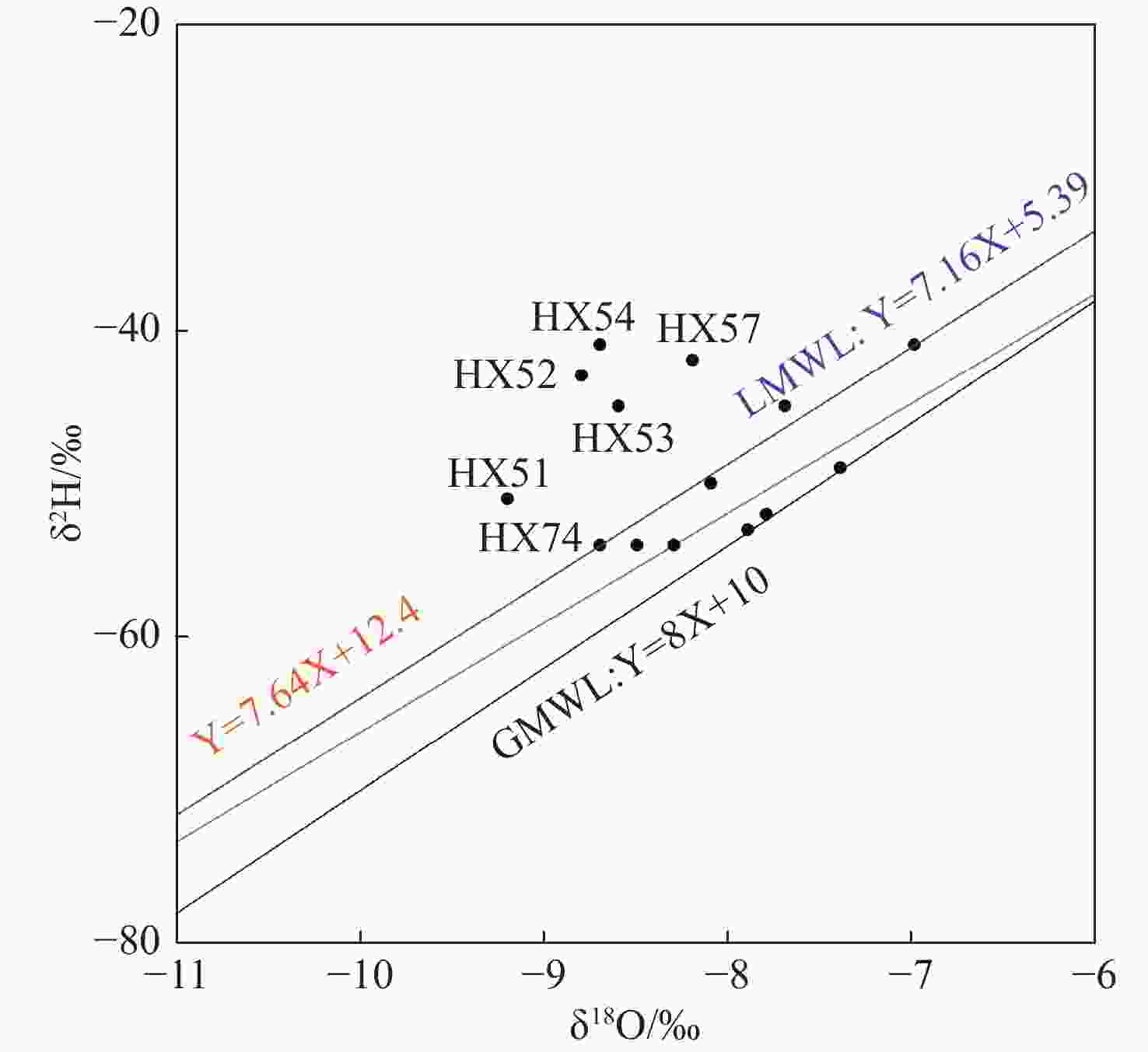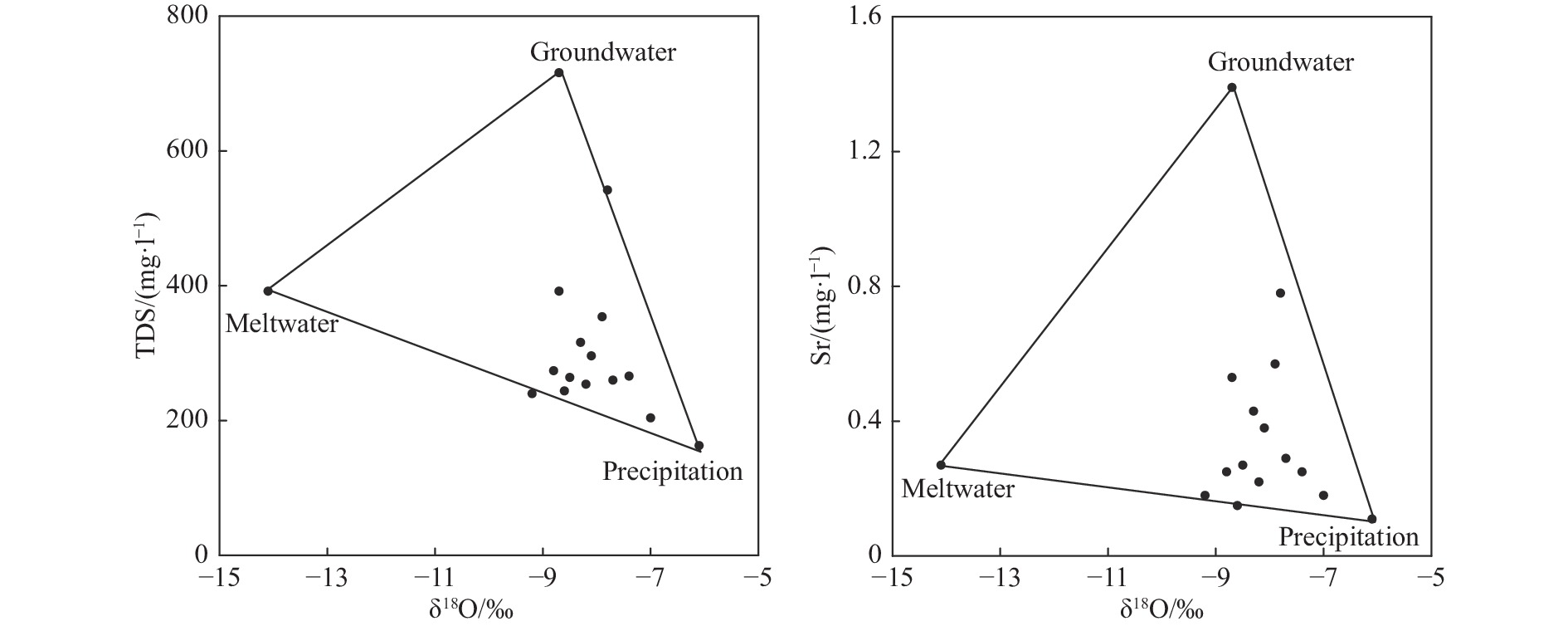Tracing runoff components in the headwater area of Heihe River by isotopes and hydrochemistry
-
Abstract: Since water resources of the Heihe River Basin are primarily in the form of surface runoff in the Qilian Mountains, identifying its sources and components is essential for researchers to understand water cycling and transformation in the basin. It will help to properly exploit water resources, and contribute to ecological environment construction. The paper uses the isotope data of hydrogen and oxygen in water and hydrochemistry data collected at a high altitude to trace the sources of surface runoff in Heihe River in rainy season and uses the three-component mixing model to estimate the contribution of each component to runoff. Results indicate that surface water consists of precipitation, melt water and groundwater, with precipitation being the primary component and contributing to 59%–64% of runoff. Melt water and groundwater account for 15%–25% and 12%–22%, respectively. Precipitation accounts for 60%, groundwater for 22% and glacial melt water for 18% of the outflow in the main stream of the Heihe River. The composition is of great significance for water cycling and conversion research as well as water resource evaluation and management.
-
Key words:
- Qilian Mountains /
- Components of surface runoff /
- Isotope /
- Mixing model
-
Table 1. Isotope data for water samples in the Qilian Mountains
No. Location Type Altitude
(m)Water
temperature
(℃)3H
(TU)δ18O
(‰)δD
(‰)Sr
(mg/L)TDS
(mg/L)Hydrochemistry
TypePrecipitation Qilian County, Sunan County Precipitation - - 62 −6.1 −45 0.18 201 HCO3-Ca-Mg HX54 98º16′41″E,39º00′35″N Surface water 3892 1 45 −8.7 −41 0.53 392 HCO3-SO4-Mg-Ca HX53 98º12′13″E,39º03′59″N Surface water 3855 7.2 43 −8.6 −45 0.15 244 HCO3-SO4-Ca-Mg HX56 98º52′53″E,38º50′50″N Surface water 3796 14.9 40 −7.4 −49 0.25 266 HCO3-SO4-Ca-Mg HX57 99º27′49″E,38º32′35″N Surface water 3435 14.6 72 −8.2 −42 0.22 254 HCO3-SO4-Ca-Mg HX39 100º53′7″E,38º03′01″N Surface water 3370 - 93 −7.8 −52 0.78 542 HCO3-SO4-Ca-Mg HX55 98º17′24″E,38º54′25″N Surface water 3301 11.6 42 −7.0 −41 0.18 204 HCO3-SO4-Ca HX51 97º47′06″E,39º20′21″N Surface water 3285 7.7 49 −9.2 −51 0.18 240 HCO3-SO4-Mg-Ca HX58 99º44′32″E,38º18′17″N Surface water 3027 12.9 63 −7.7 −45 0.29 260 HCO3-SO4-Ca-Mg HX38 100º17′20″E,38º05′27″N Surface water 2930 - 81 −7.9 −53 0.57 354 HCO3-SO4-Ca-Mg HX52 97º59′26″E,39º10′35″N Surface water 2887 12.4 42 −8.8 −43 0.25 274 HCO3-Ca-Mg HX74 99º38′17″E,39º14′41″N Spring 1910 20.6 25 −8.7 −54 1.39 716 HCO3-SO4 HX44 99º37′02″E,38º50′07″N Surface water 1900 - 31 −8.5 −54 0.27 264 HCO3-SO4-Ca-Mg HX43 99º54′08″E,38º58′05″N Surface water 1700 - 163 −8.3 −54 0.43 316 HCO3-SO4-Ca-Mg HX28 100º10′18″E,38º48′11″N Surface water 1695 14.3 58 −8.1 −50 0.38 296 HCO3-SO4-Ca-Mg Table 2. Surface runoff composition in mountainous areas
No. δ18O-TDS δ18O-Sr Meltwater
(%)Precipitation
(%)Groundwater
(%)Meltwater
(%)Precipitation
(%)Groundwater
(%)HX53 Beidahe River 28 61 11 32 68 0 HX52 Beidahe River 28 55 17 31 62 7 HX51 Beidahe River 36 55 9 31 68 2 HX54 Beidahe River 20 41 39 23 47 30 HX55 Beidahe River 9 85 6 10 86 4 HX56 West tributary of Heihe River 11 72 17 13 77 9 HX57 West tributary of Heihe River 22 64 14 24 70 6 HX58 West Tributary of Heihe River 15 69 16 16 72 12 HX28 Heihe outlet 18 60 22 19 62 19 HX38 East tributary of Heihe River 12 55 33 11 54 35 HX39 Tongziba River 0 32 68 4 44 52 HX43 Liyuanhe River outlet 19 55 25 20 57 22 HX44 Liyuanhe River 25 60 15 27 64 9 Table 3. Hydrochemistry and isotopic characteristics of water sources in mountainous areas
Type δ18O
(‰)δD
(‰)3H (TU) Sr TDS(mg/L) Hydrochemistry type Precipitation −6.1 −45 62 0.11 163 HCO3 Glacier melt water −14.1 −87 46 0.27 392 HCO3-SO4 Groundwater (HX74) −8.7 −54 25 1.39 716 HCO3-SO4 Note: Isotopic data for precipitation and glacial melt water are quoted from Nie et al. (2005) Table 4. Characteristics of average surface runoff components
Source area Number of samples Melt water (%) Precipitation (%) Groundwater (%) Beidahe River 10 25 63 12 Heihe River 10 15 64 21 Liyuanhe River 2 19 59 22 Heihe River outlet HX28 1 18 60 22 Liyuanhe River outlet HX43 1 19 55 25 -
Chang Q, Ma R, Sun Z, et al. 2018. Using isotopic and geochemical tracers to determine the contribution of glacier-snow meltwater to streamflow in a partly glacierized alpine-gorge catchment in northeastern Qinghai-Tibet Plateau. Journal of Geophysical Research: Atmospheres, 123: 10037−10056. Chen ZY, Qi JX, Zhang ZJ, et al. 2010. Application of isotopic hydrogeology in typical basins in North China. Beijing: Science Press. Clark ID, Fritz P. 1997. Environmental isotopes in Hydrogeology. Lewis Publishers. Ding HW, He ML, Cao BY, et al. 2000. The environmental geological problems of the water resources during the development and using in the area of middle and lower reaches of Heihe. Arid zone research, 17(4): 12−16. (in Chinese) Gui J, ZongjieLi ZJ, Yuan RF, et al. 2019. Hydrograph separation and the influence from climate warming on runoff in the north-eastern Tibetan Plateau. Quaternary International, 525: 45−53. Herath IK, Wu SJ, Ma MH, et al. 2019. Tracing controlling factors of riverine chemistry in a headwater tributary of the Yangtze River, China, inferred from geochemical and stable isotopic signatures. Environment Science Pollution Research, 26: 23899−23922. Fan XP. 1991. Characteristics of the stream-aquifer systems and rational utilization of water resources in the Heihe River. Gansu Geology, 12: 1−16. (in Chinese) Fang JZ, Yi P, Stockinger M, et al. 2022. Investigation of factors controlling the runoff generation mechanism using isotope tracing in large-scale nested basins. Journal of Hydrology, 615(Part A): 128728. Gao QZ, Li FX, 1991. Development and utilization of water resources in Heihe River catchment. Lanzhou: Gansu science and technology press. Kendall C, Mcdonnell JJ. 1998. Isotope tracers in catchment hydrology. Elsevier, Amsterdam. Lan YC, Kang ES, Zhang JS, et al. 2002. Study on the water resources and its rational development and utilization in Heihe River basin. Journal of Lanzhou University (Natural Sciences), 38(5): 108−114. (in Chinese) Li X, Cheng G, Fu B, et al. 2022. Linking critical zone with watershed science: The example of the Heihe River basin. Earth’s Future, 10: e2022EF002966. Li ZJ, Li ZX, Fan XJ, et al. 2020. The sources of supra-permafrost water and its hydrological effect based on stable isotopes in the third pole region. Science of The Total Environment, 715: 136911. Liu ZW, Chen RS, Song YX, et al. 2014. Water holding capacity of mosses under alpine shrubs in Qilian Mountains. Arid Land Geography, 37(4): 696−703. (in Chinese) Nie ZL, Chen ZY, Shen JM, et al. 2005. Environmental isotopes as tracers of hydrological cycle in the recharge area of the Heihe River. Geography and Geo-Information Science, 21(1): 104−108. (in Chinese) Pan Z, Ma R, SunZY, et al. 2022. Integrated hydrogeological and hydrogeochemical dataset of an alpine catchment in the northern Qinghai–Tibet Plateau. Earth System Science Data, 14: 2147−2165. Pan Z, Sun ZY, Ma R, et al. 2018. Isotopic investigation of rainfall-runoff generation in an Alpine catchment in headwater regions of Heihe river, Northeast Qinghai-Tibet Plateau. Earth Science, 43(11): 4226−4236. (in Chinese) Shi DP, Tan HB, Chen X, et al. 2021. Uncovering the mechanisms of seasonal river–groundwater circulation using isotopes and water chemistry in the middle reaches of the Yarlungzangbo River, Tibet. Journal of Hydrology, 603(Part C): 127010. Sophocleous M. 2002. Interactions between groundwater and surface water: The state of the science. Hydrogeology Journal, 10: 52–67. Wang GX, Cheng GD, 1998. Changes of hydrology and ecological environment during late 50 years in the heihe River basin. Journal of desert research, 18(3): 233-238. (in Chinese) Wang JY, Che KJ, Yan KL, et al. 1999. Analysis of the runoff components in the forestry areas of the Qilian Mountains and their temporal and spatial variation. Journal of glaciology and geocryology, 21(1): 59−63. (in Chinese) Wu B, Wang S, Wang WX, et al. 2019. Impact of future climate change on water resources in the arid regions of Northwest China based on surface water-groundwater coupling model: A case study of the middle reaches of the Heihe River. Geology in China, 46(2): 369−380. (in Chinese) Zhao LJ, Eastoe CJ, Liu XH, et al. 2018. Origin and residence time of groundwater based on stable and radioactive isotopes in the Heihe River Basin, northwestern China. Journal of Hydrology: Regional Studies, 18: 31−49. Zhao LJ, Yin L, Xiao HL, et al. 2011. Isotopic evidence for the moisture origin and composition of surface runoff in the headwaters of the Heihe River basin. Chinese Science Bulletin: 56. (in Chinese) doi: 10.1007/s11434-010-4278-x Zhang H, Chen ZY, Tang CY. 2021. Quantifying groundwater recharge and discharge for the middle reach of Heihe River of China using isotope mass balance method. Journal of Groundwater Science and Engineering, 9(3): 225−232. -

 E-mail alert
E-mail alert Rss
Rss



 下载:
下载:










